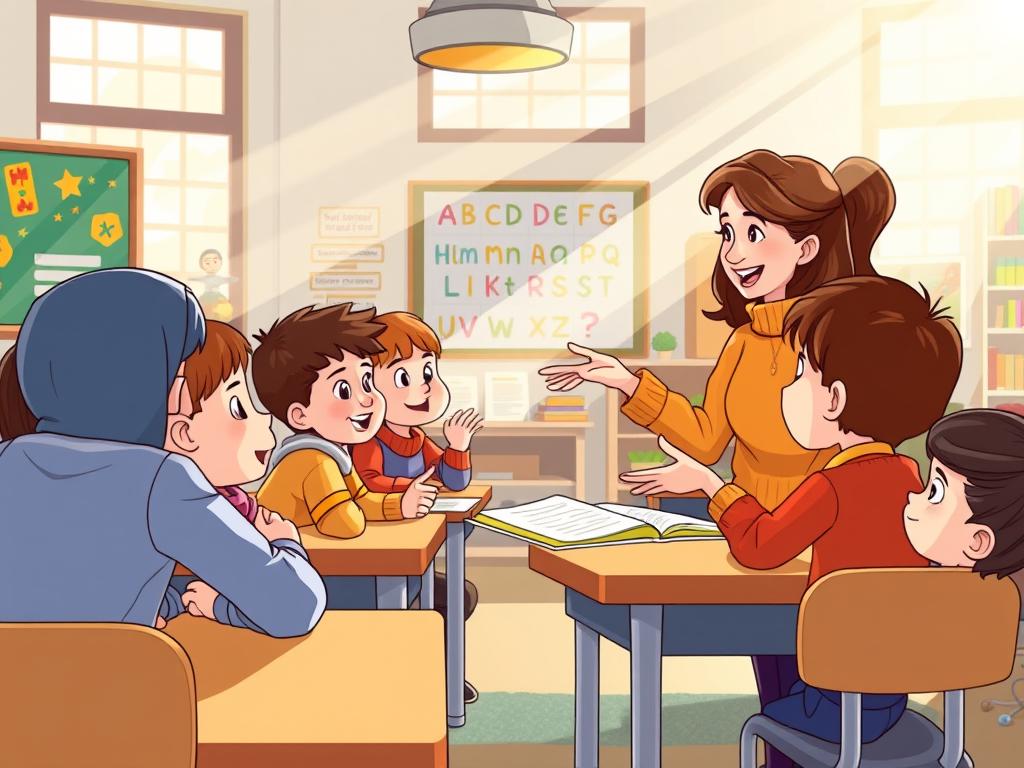Did you know that teaching introductory grammar concepts to young minds can significantly enhance their communication skills and boost their confidence? Research shows that early exposure to grammar rules helps children develop a stronger foundation in writing and expression.
As a parent or educator, you play a vital role in shaping a child’s understanding of language. By introducing basic grammar concepts in an engaging and interactive way, you can make learning fun and effective.
Effective grammar teaching is not just about rules; it’s about nurturing a child’s ability to express themselves clearly and creatively. In this article, we will explore practical tips and strategies to help you teach grammar to children.
The Importance of Early Grammar Education
Early grammar education lays the groundwork for effective communication skills in children. Grammar is the backbone of language, enabling kids to form structured sentences and making their speech and writing more coherent. By understanding grammar rules for kids, children can express their thoughts and feelings more effectively.
Building a Foundation for Lifelong Communication
Teaching fundamental grammar principles for children at an early age helps build a strong foundation for lifelong communication. It enhances their ability to convey ideas, negotiate, and resolve conflicts. As children grow, this foundation supports their academic success and personal interactions.
When children grasp the basics of grammar, they can communicate more confidently. This confidence is crucial in both personal and academic settings, allowing them to participate fully in class and engage in meaningful conversations.
How Grammar Supports Reading Comprehension
Grammar also plays a significant role in reading comprehension. By understanding the structure of sentences, children can better comprehend the texts they read. This understanding is essential for extracting meaning from written language and for developing a love for reading.
Moreover, knowledge of grammar helps children to decipher complex sentences, thereby improving their overall reading skills. As they progress in their educational journey, this skill becomes increasingly important.
In conclusion, early grammar education is vital for children’s linguistic and academic development. It not only enhances their communication skills but also supports their reading comprehension, laying a solid foundation for future success.
Child Development and Grammar Learning
Understanding how children develop cognitively is key to teaching them grammar effectively. Children’s brains are constantly processing new information, and their ability to grasp grammar concepts is closely tied to their overall cognitive development.
As you introduce grammar to young learners, it’s essential to consider their developmental stage. Children progress at different rates, but there are general age-related milestones that can guide your teaching approach.
Age-Appropriate Grammar Expectations
Children typically begin to show an understanding of basic grammar concepts between the ages of 3 and 5. At this stage, they start to use simple sentences and begin to understand the concept of word order. Easy grammar concepts for young learners include identifying nouns and verbs in simple sentences.
- Identifying and naming objects (nouns)
- Understanding basic action words (verbs)
- Recognizing simple sentence structures
Cognitive Readiness for Grammar Concepts
Cognitive readiness is crucial for learning grammar. Children need to have developed certain cognitive skills to understand and apply grammar rules. For example, they need to be able to think about language itself, not just use it. Beginner grammar concepts for kids should be introduced in a way that is engaging and challenging yet not overwhelming.
Some key cognitive skills that indicate readiness for grammar learning include:
- The ability to follow simple instructions
- An understanding of basic storytelling concepts
- The capacity to identify and mimic patterns
By understanding these developmental aspects, you can tailor your grammar teaching to meet the needs of your young learners, making the learning process more effective and enjoyable.
Create a Grammar-Friendly Learning Environment
A dedicated space for learning can make a significant difference in your child’s ability to absorb and understand simple grammar rules for children.
Set Up Your Home for Grammar Learning
To create an effective learning space, consider using visual aids like flashcards, posters, and charts. These tools can make grammar concepts more engaging and accessible. For instance, you can place a chart on the wall that illustrates different parts of speech or hang a poster that demonstrates how to form basic sentences.
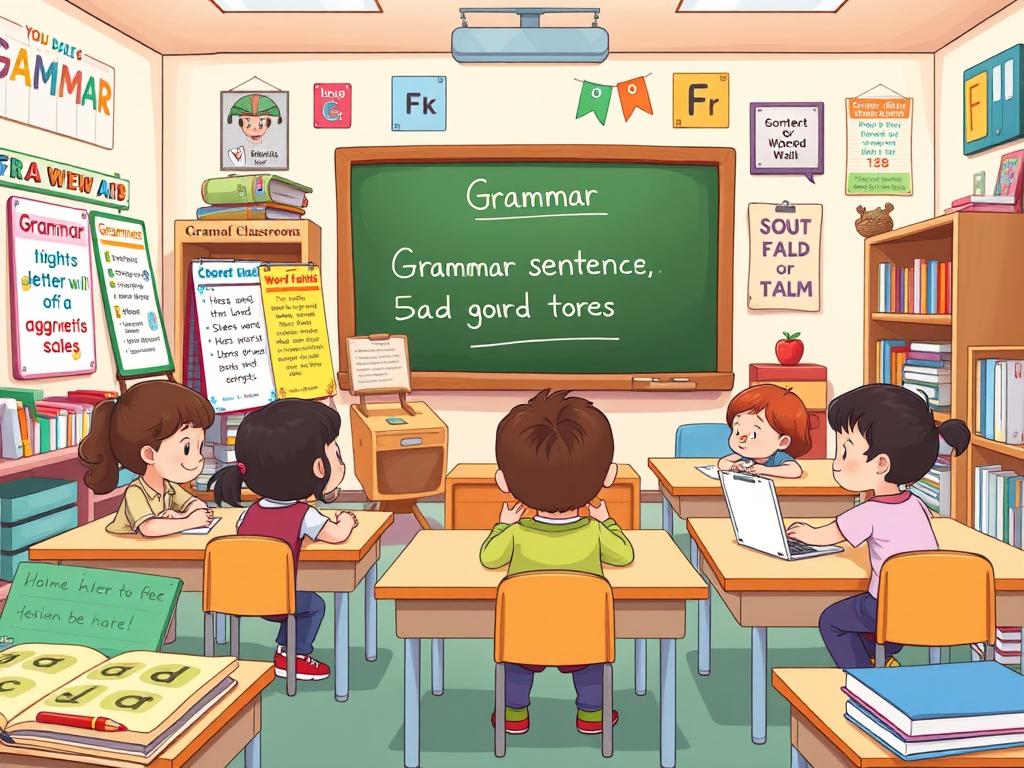
Some other ideas for setting up your home include:
- Creating a grammar corner with books and educational materials
- Using everyday objects to demonstrate grammar concepts
- Incorporating grammar into your home’s decor through fun and educational displays
Establish a Consistent Learning Routine
Consistency is key when teaching children grammar. Establishing a regular learning routine helps reinforce new concepts and makes learning a habit. You can achieve this by:
- Setting aside a specific time each day for grammar practice
- Creating a schedule that balances grammar learning with other activities
- Making grammar practice a fun and engaging experience
By implementing these strategies, you can create a supportive and engaging environment that fosters your child’s understanding and love of grammar.
Make Grammar Fun: The Key to Engagement
Grammar doesn’t have to be boring; with the right approach, it can be a fun and engaging subject for children. When kids enjoy the learning process, they’re more likely to absorb and apply grammar rules for kids effectively.
One effective way to make grammar enjoyable is by turning it into games. This approach not only makes learning fun but also interactive. You can create simple games that focus on beginner grammar concepts for kids, such as identifying nouns or verbs in sentences.
Turn Grammar into Games
Here are some ideas for grammar games:
- Grammar Bingo: Create bingo cards with different parts of speech (nouns, verbs, adjectives) and have children identify the parts of speech as you call out sentences.
- Grammar Scavenger Hunt: Hide sentences around the house or classroom with specific grammar elements (e.g., nouns, verbs) for children to find and identify.
- Grammar Charades: Act out grammar concepts, such as verbs or prepositions, for children to guess.
Use Stories to Teach Grammar Naturally
Storytelling is another powerful tool for teaching grammar. By incorporating grammar lessons into stories, you can help children see the practical application of grammar rules for kids in a more engaging and memorable way.
For example, you can read a story together and then discuss the grammar elements within it, such as identifying the main nouns and verbs or exploring how adjectives are used to describe characters.
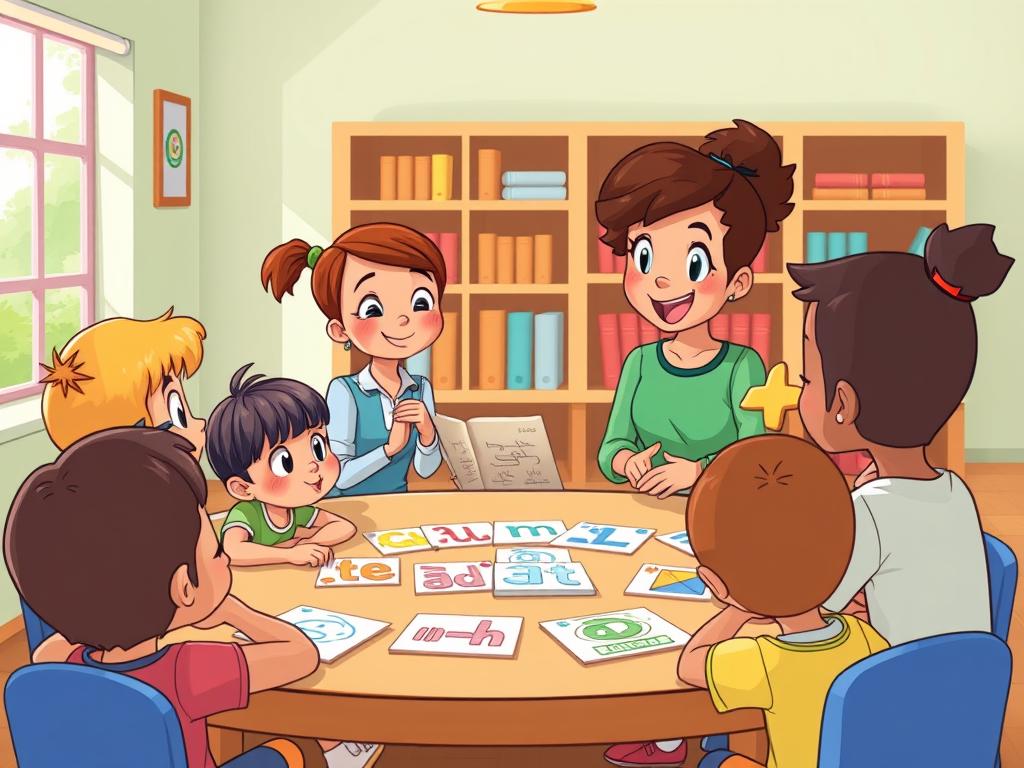
By making grammar fun through games and storytelling, you can help your child develop a strong foundation in beginner grammar concepts for kids, setting them up for success in their language learning journey.
Teaching Nouns: The Building Blocks of Language
Nouns are the foundation upon which language is built, making their instruction vital for young learners. As a fundamental aspect of basic grammar concepts for children, understanding nouns helps kids develop their communication skills. You can introduce nouns in a way that’s both fun and engaging, laying the groundwork for more complex grammar concepts down the line.
To start, it’s essential to explain what nouns are and how they’re used in everyday language. You can use simple examples that children can relate to, such as objects they see or interact with daily. This approach makes easy grammar concepts for young learners more accessible and enjoyable.
Common vs. Proper Nouns for Beginners
Distinguishing between common and proper nouns is a crucial step in noun instruction. Common nouns refer to general categories of things, like “dog” or “city,” while proper nouns are specific names, such as “John” or “New York.” Using real-life examples can help children grasp this difference.
For instance, you can explain that “dog” is a common noun because it can refer to any dog, but “Rex” is a proper noun because it’s the name of a specific dog. Making this distinction clear can help children understand how to use nouns correctly in sentences.
Singular and Plural Noun Activities
Teaching singular and plural nouns can be made fun through interactive activities. Two effective methods include household scavenger hunts and picture sorting games.
Household Scavenger Hunts
A household scavenger hunt is a great way to teach singular and plural nouns. Create a list of items for your child to find around the house, using both singular and plural forms. For example, “Find a book” (singular) and “Find three pencils” (plural). This activity encourages children to identify and understand the difference between singular and plural nouns in a practical context.
Picture Sorting Games
Picture sorting games are another engaging way to teach singular and plural nouns. Prepare a set of pictures showing singular objects (one cat) and plural objects (multiple cats). Ask your child to sort these pictures into two categories. This visual activity helps reinforce the concept of singular and plural nouns.
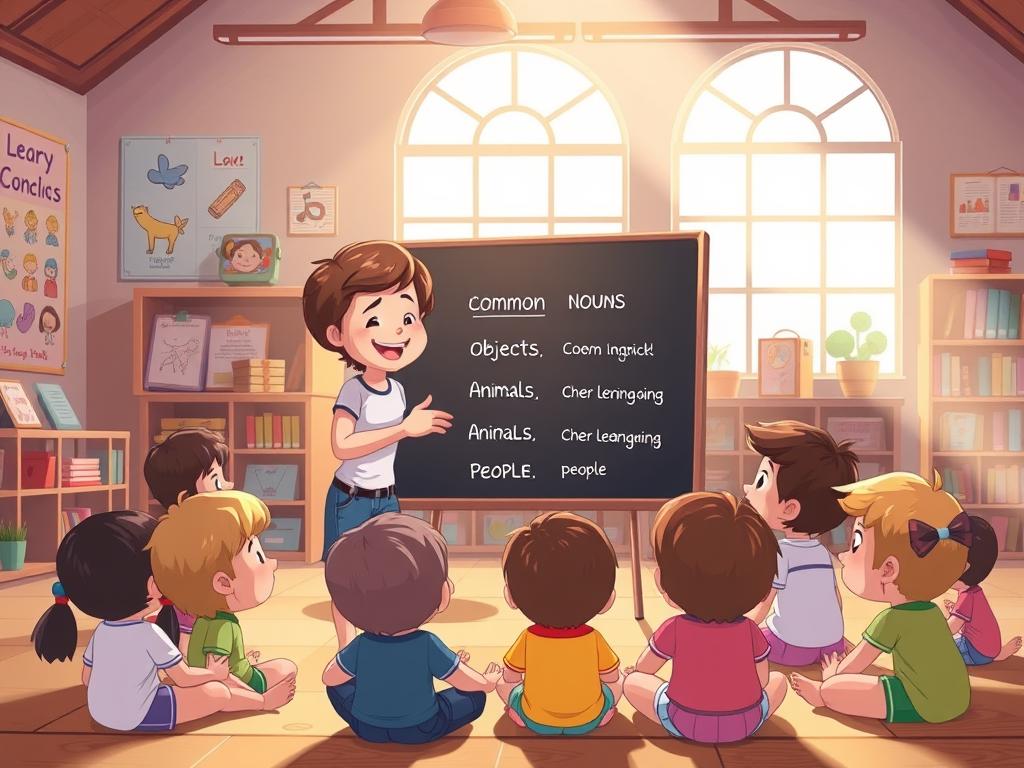
By incorporating these activities into your teaching, you can help children develop a solid understanding of nouns, enhancing their grasp of basic grammar concepts for children. Remember, the key is to make learning fun and interactive, ensuring that young learners stay engaged and motivated.
Introducing Verbs: Action Words Come Alive
As you start teaching verbs, you’ll find that using interactive methods can make a significant difference in how well children understand and use them. Verbs are the backbone of any sentence, providing the action that drives the narrative forward. By introducing verbs in a fun and engaging way, you can help children develop a stronger understanding of fundamental grammar principles for children.
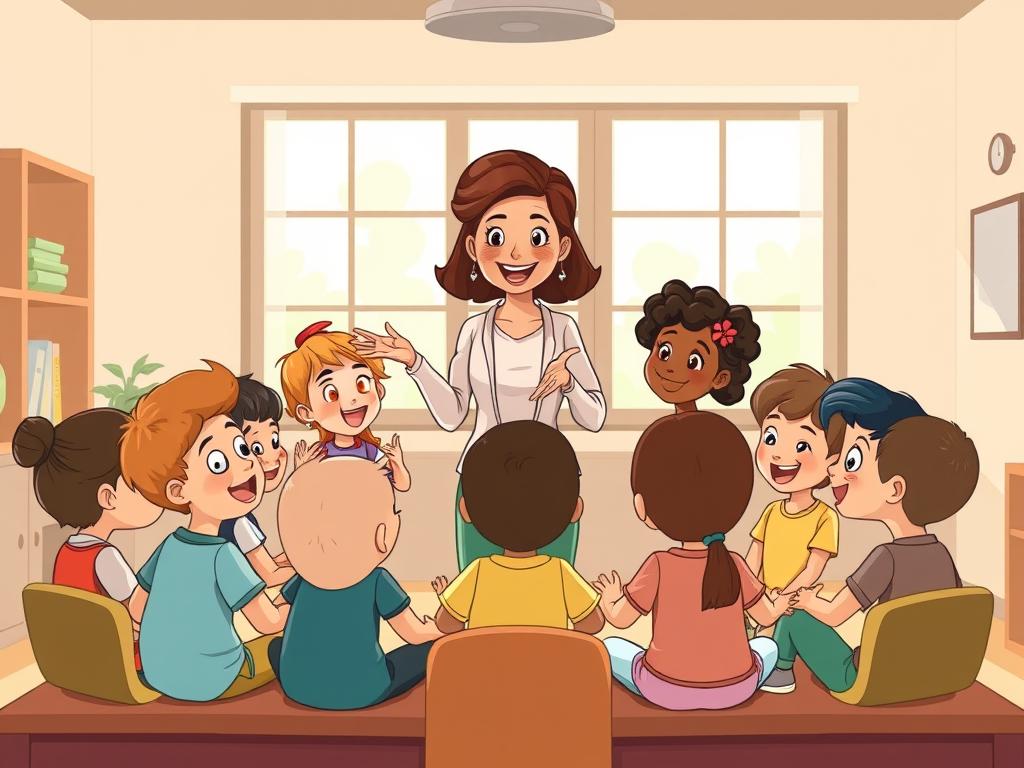
Action Verb Games and Activities
Action verbs are a great place to start when teaching children about verbs. These verbs describe physical or mental actions, such as “run,” “jump,” “think,” or “read.” To make learning these verbs engaging, you can incorporate various games and activities into your teaching.
For example, you can create a verb charades game where children act out different action verbs, and their peers have to guess the verb being acted out. This activity not only teaches children about action verbs but also encourages creativity and teamwork.
Helping Verbs Made Simple
Helping verbs, also known as auxiliary verbs, are used in conjunction with main verbs to provide more information about the action. Examples include “will,” “would,” “can,” and “could.” To simplify the concept of helping verbs for children, you can use relatable examples and interactive activities.
Role-Playing Activities
Role-playing is an effective way to teach children about both action and helping verbs. By acting out different scenarios, children can practice using verbs in context. For instance, you can create a scenario where a child has to say, “I will read a book,” using the helping verb “will” along with the action verb “read.”
Verb Charades
Building on the idea of charades, you can create a more complex version that includes helping verbs. For example, a child could act out “I can dance,” incorporating the helping verb “can” with the action verb “dance.” This activity helps children understand how helping verbs modify the main action verb.
By using a combination of these engaging activities, you can help children grasp the concept of verbs and improve their understanding of simple grammar rules for children. As children become more confident in their ability to use verbs correctly, they’ll be better equipped to construct meaningful sentences and communicate effectively.
Exploring Adjectives: Descriptive Word Fun
Adjectives bring language to life, and there are many creative ways to introduce them to young learners. Teaching adjectives to kids is essential for enhancing their descriptive language skills, allowing them to express themselves more effectively. By incorporating fun and engaging activities into their learning routine, you can help your children develop a deeper understanding of adjectives and their role in beginner grammar concepts for kids.
One effective method for teaching adjectives is through sensory experiences. By engaging children’s senses, you can help them connect adjectives to real-world experiences, making the learning process more memorable and enjoyable.
Sensory Adjective Activities
Sensory activities are an excellent way to introduce adjectives to children. For example, you can create a “taste test” with different foods, asking your kids to describe the flavors using adjectives like “sweet,” “sour,” or “spicy.” Similarly, a “touch box” filled with various textures can encourage children to use adjectives like “soft,” “rough,” or “smooth” to describe what they feel.
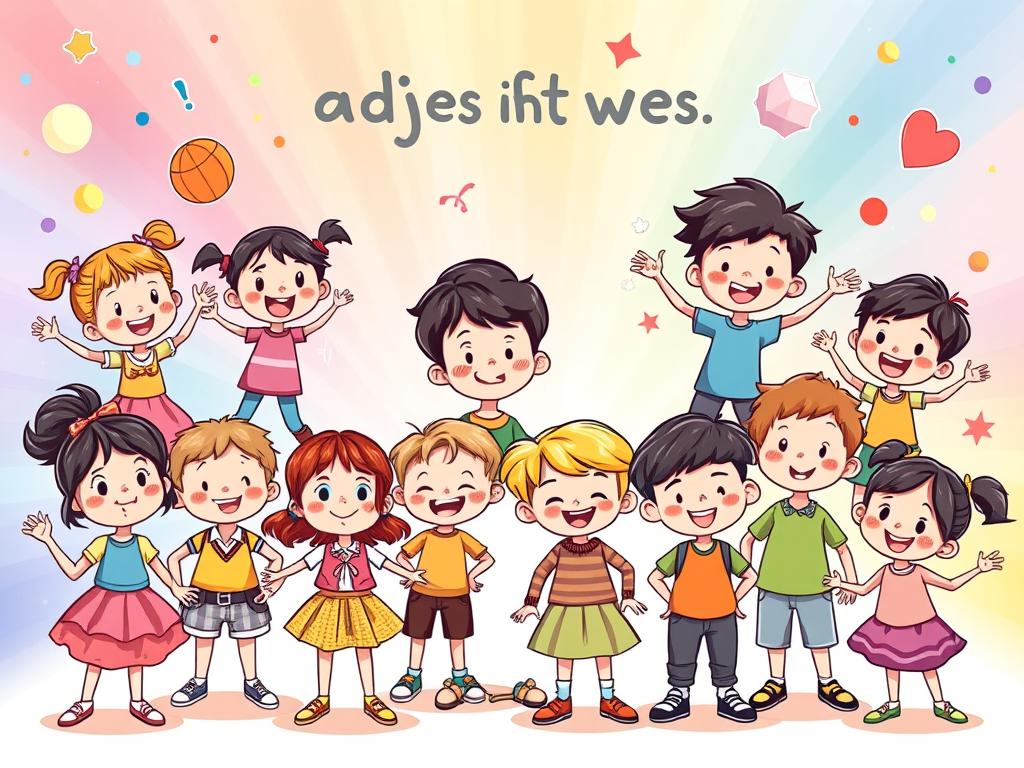
Comparative and Superlative Adjectives
As children become more comfortable with basic adjectives, you can introduce comparative and superlative forms. Using real-life examples and comparisons can help them understand the differences between “big,” “bigger,” and “biggest.” For instance, comparing the sizes of different toys or fruits can make this concept more tangible and fun.
The “Describe It” Game
A fun and interactive way to practice adjectives is through “The ‘Describe It’ Game.” In this game, one person chooses an object, and the others try to guess what it is by asking yes or no questions about its descriptive qualities, such as “Is it colorful?” or “Is it soft?” This game not only encourages the use of adjectives but also promotes critical thinking and teamwork.
By incorporating these activities into your teaching, you can help your children develop a strong foundation in basic language rules for kids, enhancing their ability to communicate effectively and creatively.
Basic Grammar Concepts for Children: A Comprehensive Approach
To effectively teach introductory grammar concepts for children, educators must adopt a multifaceted strategy. This involves integrating multiple grammar concepts together and building simple sentences step by step. By doing so, children develop a comprehensive understanding of grammar rules for kids.
Integrating multiple grammar concepts is crucial for a deep understanding of language. When children learn various concepts in isolation, they might struggle to see how these elements work together to form coherent sentences. For example, teaching nouns and verbs together allows children to understand how these parts of speech interact.
Integrate Multiple Concepts Together
One effective way to integrate multiple concepts is through interactive activities. For instance, you can create a story together with your child, taking turns to add sentences. This activity naturally incorporates various grammar elements, such as nouns, verbs, and adjectives, helping children see how these concepts work together.
Here are some key benefits of integrating multiple grammar concepts:
- Enhanced understanding of how different parts of speech interact
- Improved ability to construct meaningful sentences
- Better retention of grammar rules through practical application
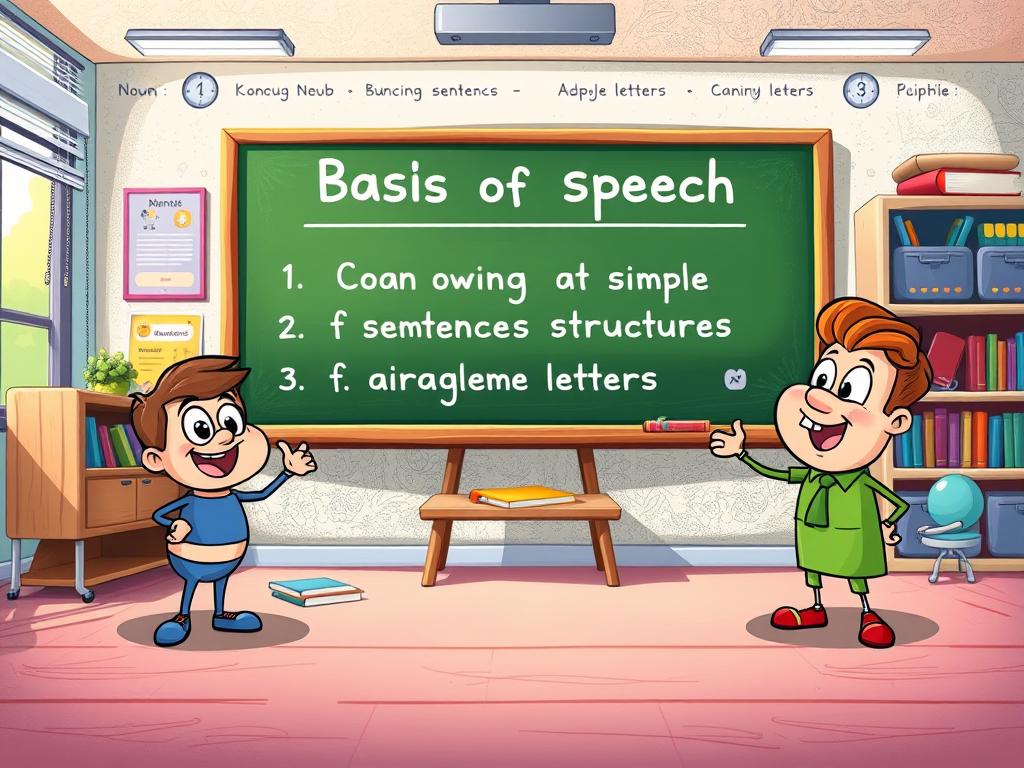
Build Simple Sentences Step by Step
Building simple sentences is a fundamental skill that children need to master. This process involves several key steps, including understanding subject-verb agreement and adding descriptive elements.
Subject-Verb Agreement
Teaching subject-verb agreement is essential for constructing grammatically correct sentences. Children need to understand that a singular subject takes a singular verb, while a plural subject takes a plural verb. You can practice this concept through simple exercises, such as filling in the blanks with the correct verb form.
Add Descriptive Elements
Once children are comfortable with basic sentence structures, they can learn to add descriptive elements. This includes adjectives and adverbs that provide more detail about the nouns and verbs in their sentences. For example, instead of saying “The dog ran,” they can say “The big, fluffy dog ran quickly.”
By following these steps and practicing regularly, children can develop a strong foundation in grammar rules for kids. This comprehensive approach not only enhances their understanding of grammar but also improves their overall communication skills.
Teaching Pronouns: Replacing Those Nouns
Understanding pronouns is key to clear and efficient communication, making it an important concept for young learners. Pronouns replace nouns in sentences, making language more efficient and easier to understand. As you teach pronouns to your children, you’ll be helping them improve their communication skills.
Pronouns are essential for simple and effective communication. By using pronouns, children can avoid repeating names or nouns multiple times in a sentence or conversation, making their language more engaging and fluid.
Personal Pronouns Made Easy
Start by introducing personal pronouns such as “I,” “you,” “he,” “she,” “it,” “we,” and “they.” You can make this fun by using simple examples that children can relate to. For instance, you can say, “I am reading a book, you are reading a book,” and so on, to demonstrate how personal pronouns replace names.
Using games and activities can also help. For example, you can play a game where you point to different people or objects and ask your child to identify them using the correct personal pronoun.

Possessive Pronouns Through Storytelling
Possessive pronouns like “mine,” “yours,” “his,” “hers,” “its,” “ours,” and “theirs” can be introduced through storytelling. Read a story together and point out objects belonging to different characters, using possessive pronouns to describe them.
Pronoun Replacement Activities
To reinforce understanding, engage your child in pronoun replacement activities. For example, take a simple sentence like “Sarah is reading a book” and replace “Sarah” with “she” to get “She is reading a book.” You can use various sentences and encourage your child to replace nouns with the appropriate pronouns.
By making these activities fun and engaging, you can help your child grasp the concept of pronouns easily. This will not only improve their grammar but also enhance their overall communication skills, teaching them simple grammar rules for children in an enjoyable way.
Understanding Prepositions: Words That Show Relationships
Prepositions are a fundamental part of language, and teaching them effectively is key to enhancing children’s communication skills. Prepositions indicate relationships between objects and locations, and understanding them is crucial for kids to grasp the nuances of language.
You can start by explaining that prepositions are words that show how things are related to each other, such as “in,” “on,” “under,” and “above.” These words help children describe where things are and how they are positioned relative to other objects.
Physical Demonstrations of Prepositions
One effective way to teach prepositions is through physical demonstrations. You can use objects around the house to show what different prepositions mean. For example, you can place a toy on a table, under the table, or beside it. This hands-on approach helps children visualize and understand the concepts better.
For instance, you can say, “Let’s put the book on the shelf” or “The cat is hiding under the bed.” By acting out these prepositions, you make the abstract concepts more concrete for your child.
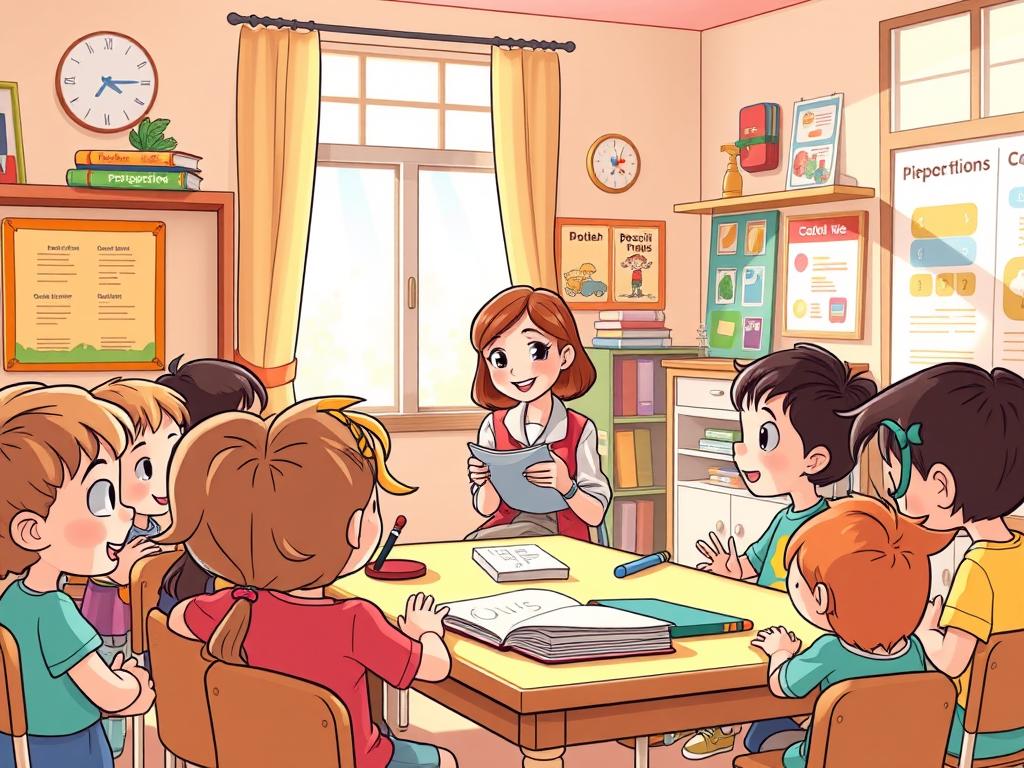
Preposition Games and Activities
Games and activities are another great way to teach prepositions. They make learning fun and engaging, which is essential for keeping children interested and motivated.
- Create a scavenger hunt with clues that use prepositions, such as “Find the toy that is under the pillow.”
- Play “Simon Says” with preposition commands, like “Simon says put your hand on your head.”
The “Where Is It?” Game
The “Where Is It?” game is a simple yet effective activity. Hide an object and give clues using prepositions to help your child find it. For example, “It’s behind the curtain” or “It’s next to the vase.” This game not only teaches prepositions but also enhances problem-solving skills.
By incorporating these methods into your teaching, you can help your child develop a strong understanding of prepositions and improve their overall language skills.
Simple Punctuation Rules for Young Learners
Punctuation is the unsung hero of clear communication, and teaching its basics to children can be both fun and rewarding. As your child begins to explore the world of writing, understanding simple punctuation rules becomes essential for conveying their thoughts and ideas effectively.
To start, it’s crucial to introduce punctuation marks that are used frequently in everyday writing. This includes periods, question marks, and exclamation points, which are fundamental in expressing different types of sentences.
Periods, Question Marks, and Exclamation Points
Begin by explaining the role of periods in ending statements, question marks in forming questions, and exclamation points in expressing strong emotions. You can use simple examples to illustrate how these punctuation marks change the meaning of sentences.
For instance, “You are going.” (statement), “Are you going?” (question), and “You are going!” (exclamation) demonstrate how punctuation affects the tone and purpose of a sentence.
Introducing Commas and Quotation Marks
Once your child is comfortable with basic sentence-ending punctuation, you can introduce commas and quotation marks. Commas help in listing items or separating clauses, while quotation marks are used to indicate direct speech or quotations.
Activities such as punctuating simple sentences or identifying where commas and quotation marks should be used can be very engaging.
Punctuation Scavenger Hunts
A fun and interactive way to reinforce punctuation learning is through scavenger hunts. Create a list of punctuation marks and have your child find examples in books, signs, or labels around the house or classroom. This activity not only makes learning punctuation enjoyable but also highlights its practical application in everyday life.
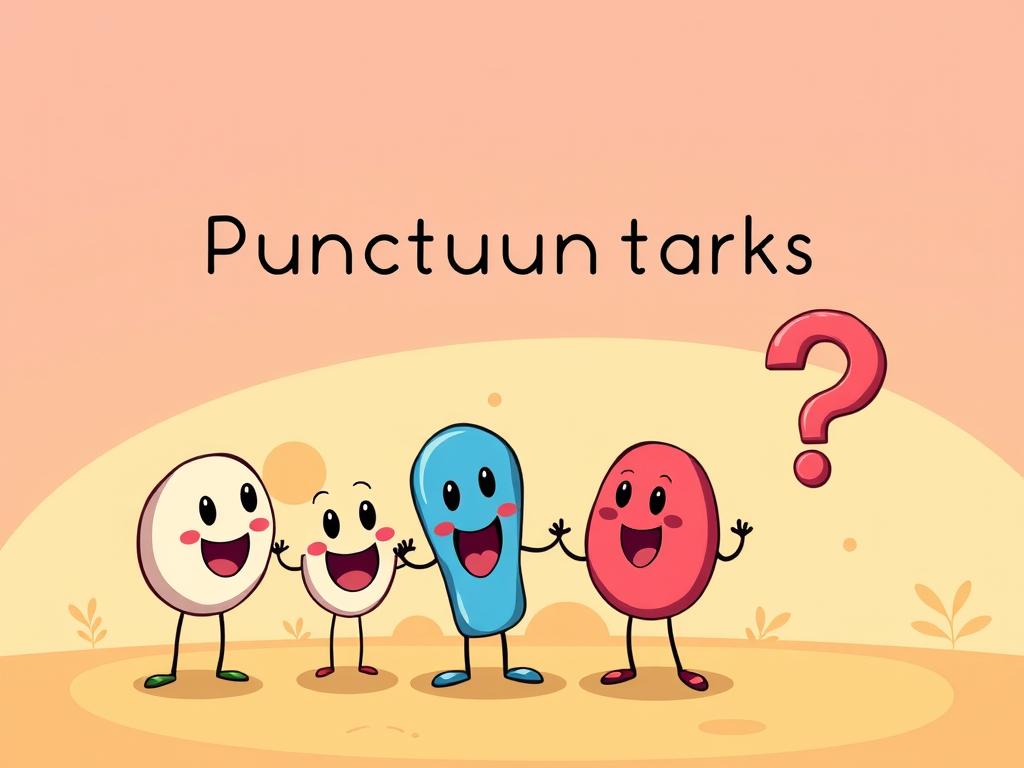
By introducing simple punctuation rules and making them fun to learn, you’re laying a strong foundation for your child’s writing skills. As they progress, they will become more confident in expressing themselves clearly and effectively.
Grammar Resources and Tools for Parents and Educators
Effective grammar instruction requires a combination of traditional teaching methods and modern educational resources. As a parent or educator, having access to a diverse range of tools can significantly enhance a child’s learning experience. You can make grammar lessons more engaging and effective by incorporating various materials into your teaching.
Age-Appropriate Grammar Workbooks and Materials
Workbooks and printed materials remain a staple in grammar education. They offer structured lessons and exercises that cater to different age groups and learning levels. When selecting workbooks, look for ones that are designed for your child’s age and skill level. Some popular options include:
- Grammar workbooks specifically designed for young learners
- Activity books that incorporate grammar exercises into fun tasks
- Textbooks that gradually introduce more complex grammar concepts
Digital Resources: Apps, Websites, and Educational Shows
In today’s digital age, there’s a wealth of online resources available to support grammar learning. These include educational apps, websites, and TV shows that can make learning grammar more engaging and interactive. Some examples include:
- Grammar apps that offer interactive exercises and games
- Websites providing detailed explanations and practice exercises
- Educational TV shows that incorporate grammar lessons into their content
Creating Your Own Grammar Materials
While there are many pre-made resources available, you can also create your own customized grammar materials. This can be particularly useful for addressing your child’s specific needs or interests. Consider:
- Developing personalized worksheets based on your child’s current grammar curriculum
- Creating flashcards to help reinforce new vocabulary and grammar rules
- Designing games and activities that focus on specific grammar concepts
By combining these resources and approaches, you can create a comprehensive and engaging grammar learning program for your child. Remember, the key is to remain flexible and adapt your teaching methods as your child grows and learns.
Overcoming Common Grammar Learning Challenges
The journey to mastering grammar can be complex, with various obstacles that both children and educators must overcome. As children progress in their learning, they may encounter specific grammar concepts that prove difficult to grasp.
When Children Struggle with Specific Concepts
Children may struggle with certain aspects of grammar, such as understanding the difference between nouns and verbs or mastering the use of pronouns. Identifying these challenges early on is crucial to providing the necessary support. For instance, using visual aids and real-life examples can help clarify complex grammar rules.
“Grammar is not just about rules; it’s about understanding how language works,” says a renowned linguist. This perspective underscores the importance of making grammar learning engaging and relevant.
“The way we teach grammar can either inspire or discourage a child’s love for language.”
Address Resistance to Grammar Learning
Some children may resist grammar learning due to its abstract nature or because they find it boring. To combat this, educators can incorporate games and interactive activities into their teaching methods.
- Grammar-based board games
- Storytelling with a focus on grammar
- Interactive online resources
Adapt Teaching Methods to Learning Styles
Every child has a unique learning style, and adapting teaching methods to these styles can significantly enhance grammar learning. For visual learners, diagrams and charts can be particularly helpful. Auditory learners may benefit from songs and rhymes that teach grammar concepts.
By recognizing the challenges children face in grammar learning and adapting our teaching approaches, we can make the process more effective and enjoyable. This not only helps children grasp simple grammar rules but also fosters a deeper understanding of language as a whole.
Teaching grammar to children can be a rewarding experience when approached with creativity and the right strategies. By making grammar fun and engaging, you can help children develop a strong foundation in language skills. You have learned various methods to introduce fundamental grammar principles for children, from creating a grammar-friendly environment to using games and stories.
As you continue to teach introductory grammar concepts for children, remember that consistency and patience are key. Encourage your children to practice regularly, and be sure to provide positive feedback on their progress. With time and effort, they will become proficient in using grammar to communicate effectively.
By applying the techniques discussed, you can help children build a strong understanding of grammar and set them up for success in their language development journey. You are now equipped with the tools and knowledge to make learning grammar an enjoyable experience for children.
Key Takeaways
- Early grammar teaching enhances communication skills.
- Interactive methods make learning grammar fun.
- Grammar rules help children develop writing skills.
- Confidence in expression is boosted through grammar knowledge.
- Practical strategies can be applied in daily teaching.
Additional Resources:
Here are 15 online blogs and articles related to teaching basic grammar concepts to children:
1. Grammarly Blog – “How to Teach Grammar to Kids: 6 Fun and Engaging Ways”
🔗 https://www.grammarly.com/blog/teach-grammar-to-kids/
2. Scholastic – “6 Ways to Make Teaching Grammar Fun”
🔗 https://www.scholastic.com/teachers/articles/teaching-content/6-ways-make-teaching-grammar-fun/
3. Education.com – “Fun Grammar Activities for Kids”
🔗 https://www.education.com/resources/grammar/
4. Reading Eggs – “5 Tips for Teaching Grammar to Children”
🔗 https://readingeggs.com/articles/teaching-grammar-to-kids/
5. Busy Teacher – “How to Teach Grammar to Young Learners”
🔗 https://busyteacher.org/how-to-teach-grammar-to-young-learners/
6. Teach Starter – “15 Fun Ways to Teach Grammar in the Classroom”
🔗 https://www.teachstarter.com/us/blog/15-ways-teach-grammar-fun-engaging-way-us/
7. Oxford Owl – “Grammar for Kids: How to Make It Fun”
🔗 https://home.oxfordowl.co.uk/english/primary-grammar/grammar-for-kids/
8. WeAreTeachers – “20 Grammar Activities to Use in the Classroom”
🔗 https://www.weareteachers.com/grammar-activities/
9. ThoughtCo – “How to Teach Grammar to ESL Students” (Adaptable for Kids)
🔗 https://www.thoughtco.com/how-to-teach-grammar-to-esl-students-1210489
10. The Measured Mom – “Grammar Activities for Kids”
🔗 https://www.themeasuredmom.com/grammar-activities-for-kids/
11. K5 Learning – “Why Grammar Practice Is Important for Kids”
🔗 https://www.k5learning.com/blog/why-grammar-practice-important-kids
12. FluentU – “10 Creative Ways to Teach Grammar to Kids”
🔗 https://www.fluentu.com/blog/educator/teach-grammar-to-kids/
13. KidsKonnect – “How to Teach Grammar to Young Learners”
🔗 https://kidskonnect.com/articles/teaching-grammar-young-learners/
14. The Classroom – “Fun Grammar Games for Kids”
🔗 https://www.theclassroom.com/fun-grammar-games-kids-8057869.html
15. Really Learn English – “How to Teach English Grammar to Children”
🔗 https://www.really-learn-english.com/teach-grammar-to-children.html
These resources offer a mix of strategies, activities, and lesson plans to make grammar engaging and effective for young learners.

